System Analysis and Design
VerifiedAdded on 2023/04/08
|12
|2033
|160
AI Summary
This report provides a detailed analysis of the system analysis and design process, focusing on facility management in a gymnasium. It covers the six core phases of SDLC, including requirement gathering and analysis, design, implementation, testing, deployment, and maintenance. The report includes class diagrams, use case diagrams, and PERT/CPM charts to illustrate the concepts. It also discusses the importance of proper requirements gathering and analysis, as well as effective staff roster scheduling and registration management.
Contribute Materials
Your contribution can guide someone’s learning journey. Share your
documents today.
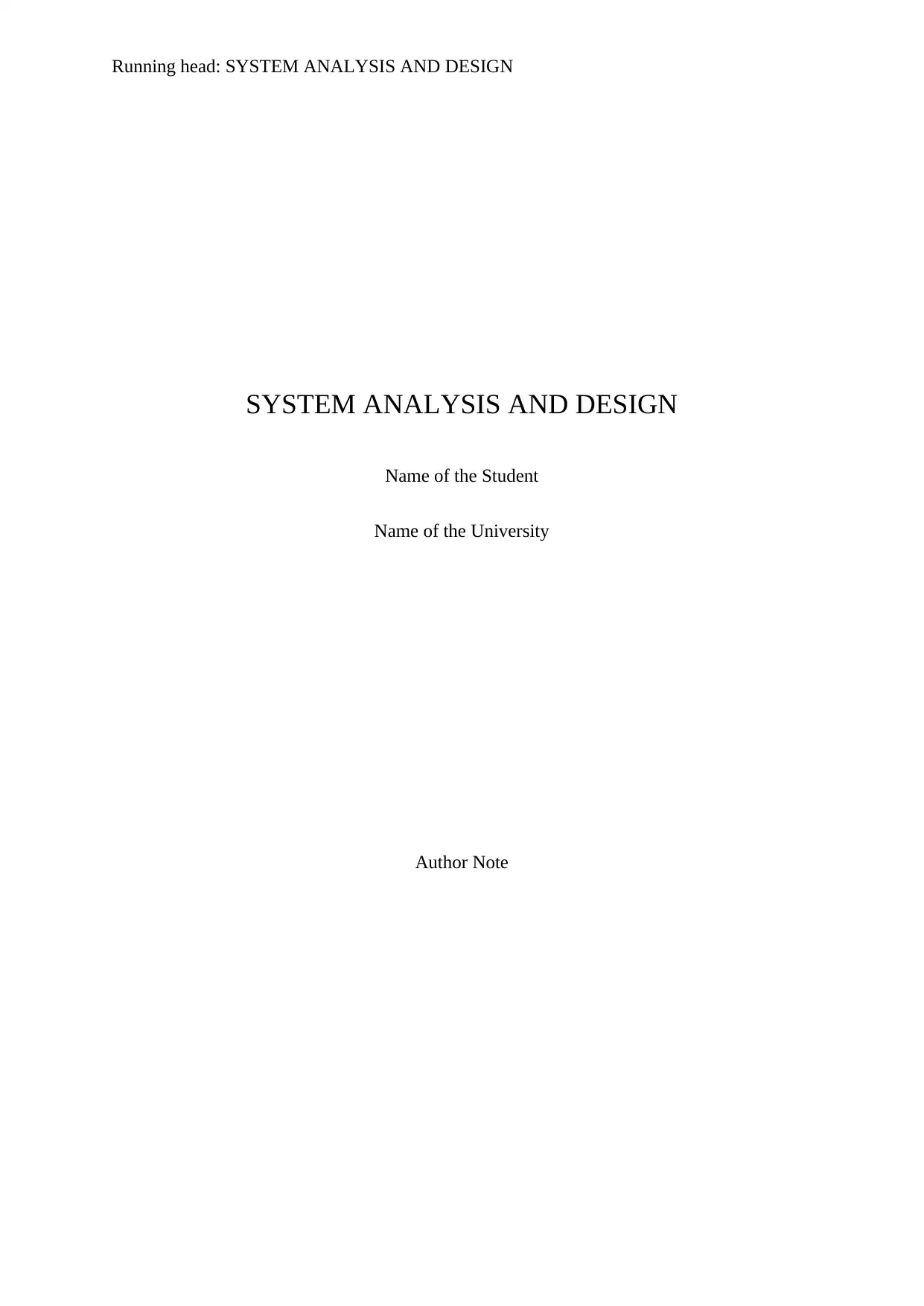
Running head: SYSTEM ANALYSIS AND DESIGN
SYSTEM ANALYSIS AND DESIGN
Name of the Student
Name of the University
Author Note
SYSTEM ANALYSIS AND DESIGN
Name of the Student
Name of the University
Author Note
Secure Best Marks with AI Grader
Need help grading? Try our AI Grader for instant feedback on your assignments.
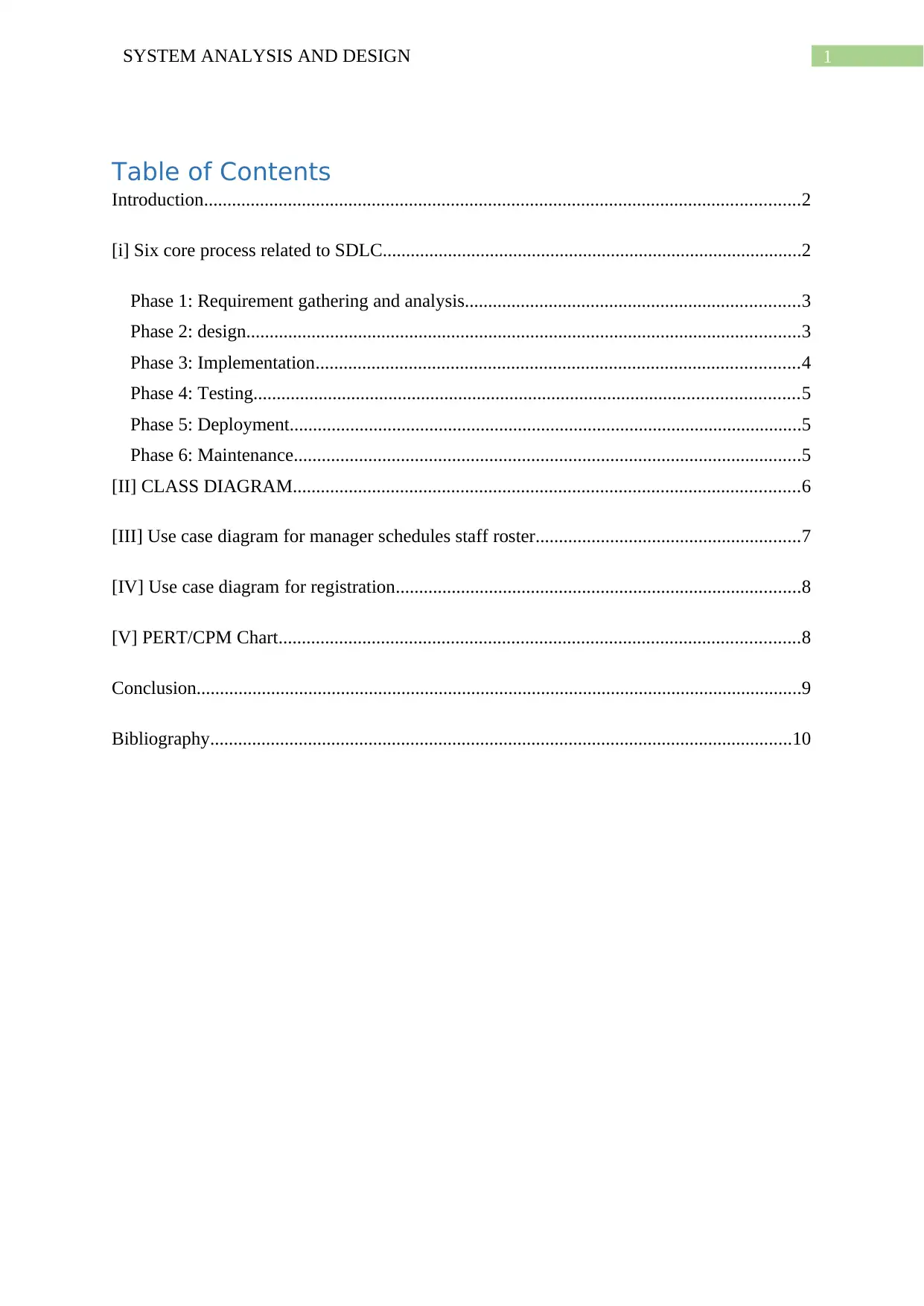
1SYSTEM ANALYSIS AND DESIGN
Table of Contents
Introduction................................................................................................................................2
[i] Six core process related to SDLC..........................................................................................2
Phase 1: Requirement gathering and analysis........................................................................3
Phase 2: design.......................................................................................................................3
Phase 3: Implementation........................................................................................................4
Phase 4: Testing.....................................................................................................................5
Phase 5: Deployment..............................................................................................................5
Phase 6: Maintenance.............................................................................................................5
[II] CLASS DIAGRAM.............................................................................................................6
[III] Use case diagram for manager schedules staff roster.........................................................7
[IV] Use case diagram for registration.......................................................................................8
[V] PERT/CPM Chart................................................................................................................8
Conclusion..................................................................................................................................9
Bibliography.............................................................................................................................10
Table of Contents
Introduction................................................................................................................................2
[i] Six core process related to SDLC..........................................................................................2
Phase 1: Requirement gathering and analysis........................................................................3
Phase 2: design.......................................................................................................................3
Phase 3: Implementation........................................................................................................4
Phase 4: Testing.....................................................................................................................5
Phase 5: Deployment..............................................................................................................5
Phase 6: Maintenance.............................................................................................................5
[II] CLASS DIAGRAM.............................................................................................................6
[III] Use case diagram for manager schedules staff roster.........................................................7
[IV] Use case diagram for registration.......................................................................................8
[V] PERT/CPM Chart................................................................................................................8
Conclusion..................................................................................................................................9
Bibliography.............................................................................................................................10
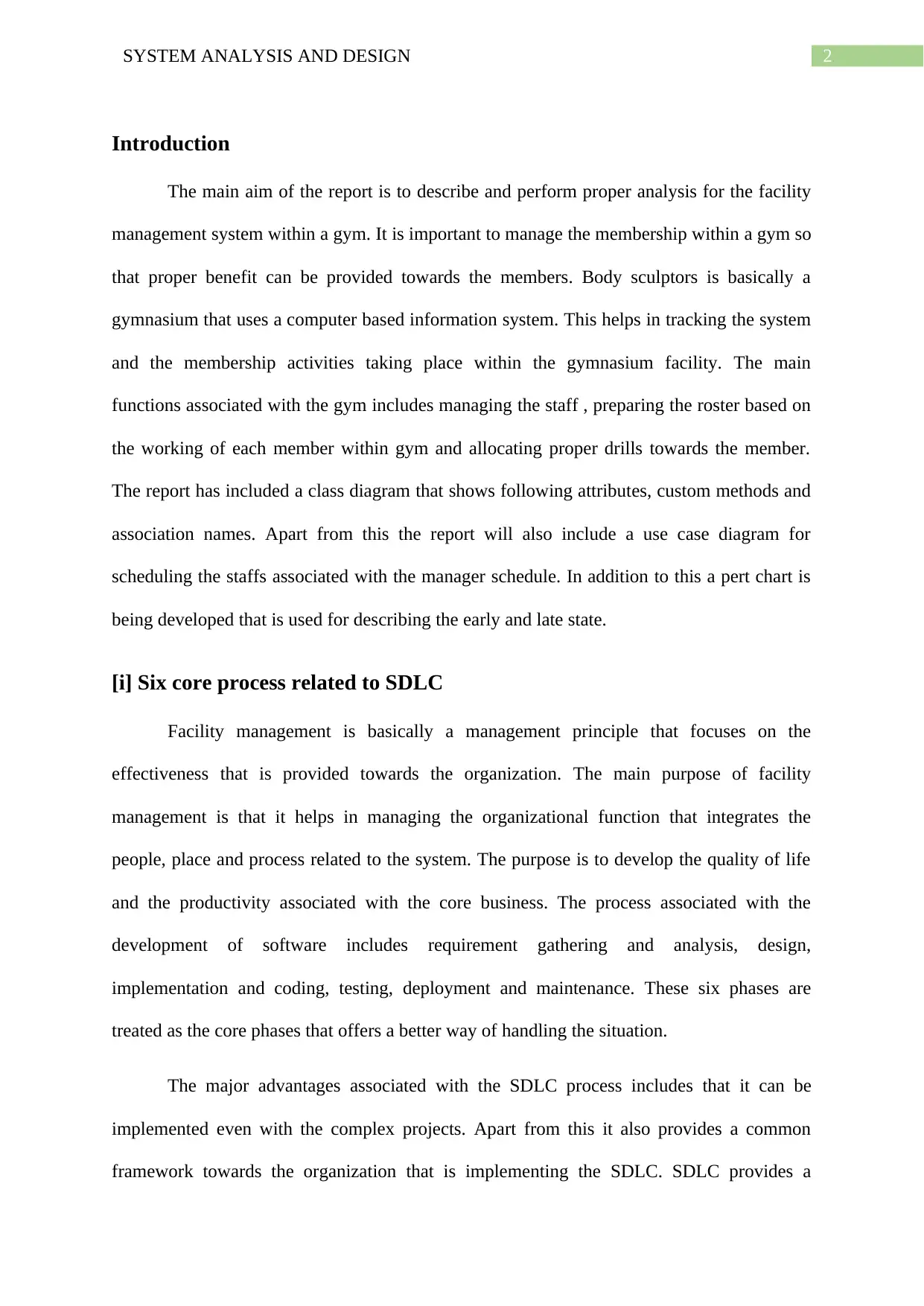
2SYSTEM ANALYSIS AND DESIGN
Introduction
The main aim of the report is to describe and perform proper analysis for the facility
management system within a gym. It is important to manage the membership within a gym so
that proper benefit can be provided towards the members. Body sculptors is basically a
gymnasium that uses a computer based information system. This helps in tracking the system
and the membership activities taking place within the gymnasium facility. The main
functions associated with the gym includes managing the staff , preparing the roster based on
the working of each member within gym and allocating proper drills towards the member.
The report has included a class diagram that shows following attributes, custom methods and
association names. Apart from this the report will also include a use case diagram for
scheduling the staffs associated with the manager schedule. In addition to this a pert chart is
being developed that is used for describing the early and late state.
[i] Six core process related to SDLC
Facility management is basically a management principle that focuses on the
effectiveness that is provided towards the organization. The main purpose of facility
management is that it helps in managing the organizational function that integrates the
people, place and process related to the system. The purpose is to develop the quality of life
and the productivity associated with the core business. The process associated with the
development of software includes requirement gathering and analysis, design,
implementation and coding, testing, deployment and maintenance. These six phases are
treated as the core phases that offers a better way of handling the situation.
The major advantages associated with the SDLC process includes that it can be
implemented even with the complex projects. Apart from this it also provides a common
framework towards the organization that is implementing the SDLC. SDLC provides a
Introduction
The main aim of the report is to describe and perform proper analysis for the facility
management system within a gym. It is important to manage the membership within a gym so
that proper benefit can be provided towards the members. Body sculptors is basically a
gymnasium that uses a computer based information system. This helps in tracking the system
and the membership activities taking place within the gymnasium facility. The main
functions associated with the gym includes managing the staff , preparing the roster based on
the working of each member within gym and allocating proper drills towards the member.
The report has included a class diagram that shows following attributes, custom methods and
association names. Apart from this the report will also include a use case diagram for
scheduling the staffs associated with the manager schedule. In addition to this a pert chart is
being developed that is used for describing the early and late state.
[i] Six core process related to SDLC
Facility management is basically a management principle that focuses on the
effectiveness that is provided towards the organization. The main purpose of facility
management is that it helps in managing the organizational function that integrates the
people, place and process related to the system. The purpose is to develop the quality of life
and the productivity associated with the core business. The process associated with the
development of software includes requirement gathering and analysis, design,
implementation and coding, testing, deployment and maintenance. These six phases are
treated as the core phases that offers a better way of handling the situation.
The major advantages associated with the SDLC process includes that it can be
implemented even with the complex projects. Apart from this it also provides a common
framework towards the organization that is implementing the SDLC. SDLC provides a
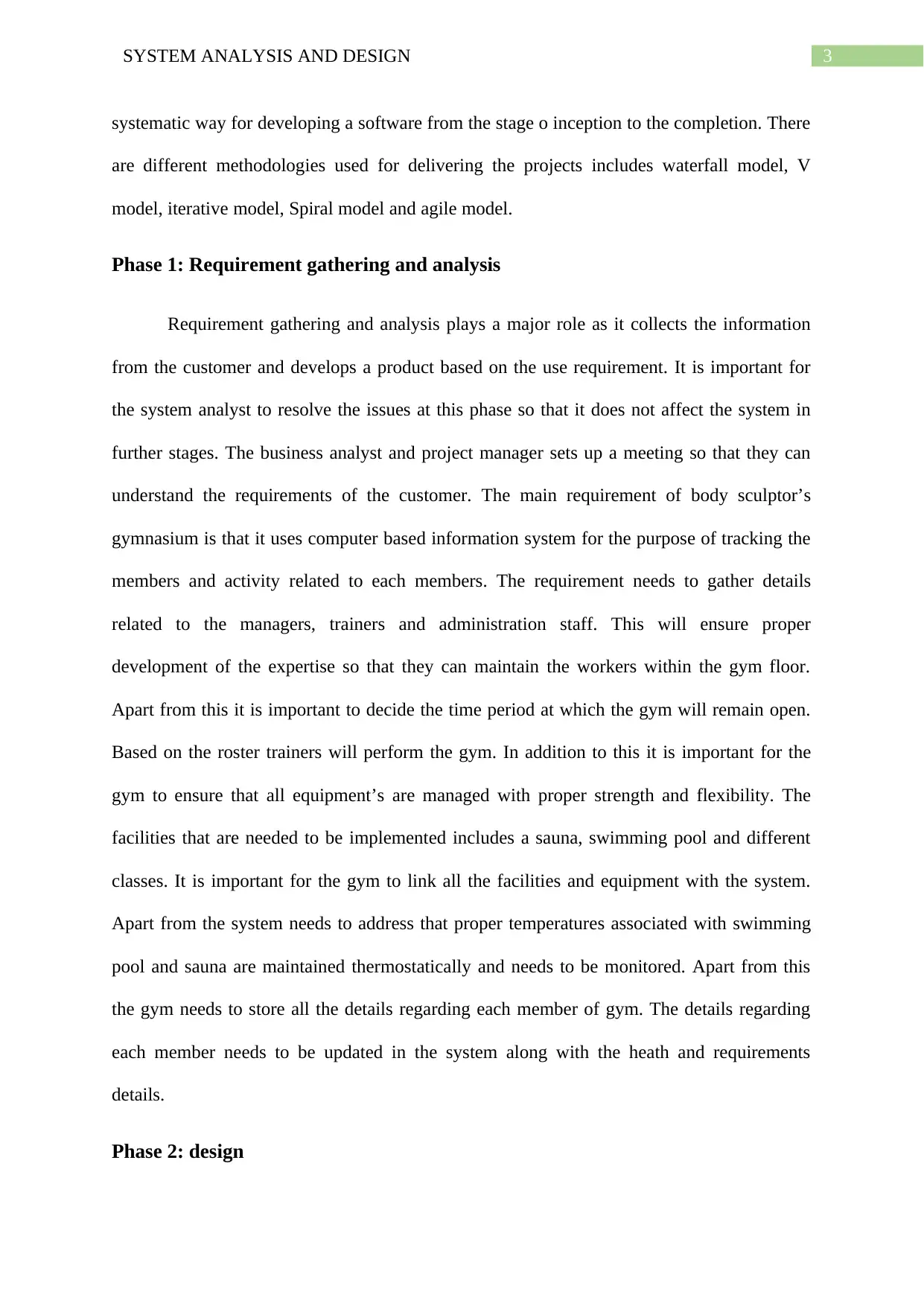
3SYSTEM ANALYSIS AND DESIGN
systematic way for developing a software from the stage o inception to the completion. There
are different methodologies used for delivering the projects includes waterfall model, V
model, iterative model, Spiral model and agile model.
Phase 1: Requirement gathering and analysis
Requirement gathering and analysis plays a major role as it collects the information
from the customer and develops a product based on the use requirement. It is important for
the system analyst to resolve the issues at this phase so that it does not affect the system in
further stages. The business analyst and project manager sets up a meeting so that they can
understand the requirements of the customer. The main requirement of body sculptor’s
gymnasium is that it uses computer based information system for the purpose of tracking the
members and activity related to each members. The requirement needs to gather details
related to the managers, trainers and administration staff. This will ensure proper
development of the expertise so that they can maintain the workers within the gym floor.
Apart from this it is important to decide the time period at which the gym will remain open.
Based on the roster trainers will perform the gym. In addition to this it is important for the
gym to ensure that all equipment’s are managed with proper strength and flexibility. The
facilities that are needed to be implemented includes a sauna, swimming pool and different
classes. It is important for the gym to link all the facilities and equipment with the system.
Apart from the system needs to address that proper temperatures associated with swimming
pool and sauna are maintained thermostatically and needs to be monitored. Apart from this
the gym needs to store all the details regarding each member of gym. The details regarding
each member needs to be updated in the system along with the heath and requirements
details.
Phase 2: design
systematic way for developing a software from the stage o inception to the completion. There
are different methodologies used for delivering the projects includes waterfall model, V
model, iterative model, Spiral model and agile model.
Phase 1: Requirement gathering and analysis
Requirement gathering and analysis plays a major role as it collects the information
from the customer and develops a product based on the use requirement. It is important for
the system analyst to resolve the issues at this phase so that it does not affect the system in
further stages. The business analyst and project manager sets up a meeting so that they can
understand the requirements of the customer. The main requirement of body sculptor’s
gymnasium is that it uses computer based information system for the purpose of tracking the
members and activity related to each members. The requirement needs to gather details
related to the managers, trainers and administration staff. This will ensure proper
development of the expertise so that they can maintain the workers within the gym floor.
Apart from this it is important to decide the time period at which the gym will remain open.
Based on the roster trainers will perform the gym. In addition to this it is important for the
gym to ensure that all equipment’s are managed with proper strength and flexibility. The
facilities that are needed to be implemented includes a sauna, swimming pool and different
classes. It is important for the gym to link all the facilities and equipment with the system.
Apart from the system needs to address that proper temperatures associated with swimming
pool and sauna are maintained thermostatically and needs to be monitored. Apart from this
the gym needs to store all the details regarding each member of gym. The details regarding
each member needs to be updated in the system along with the heath and requirements
details.
Phase 2: design
Secure Best Marks with AI Grader
Need help grading? Try our AI Grader for instant feedback on your assignments.
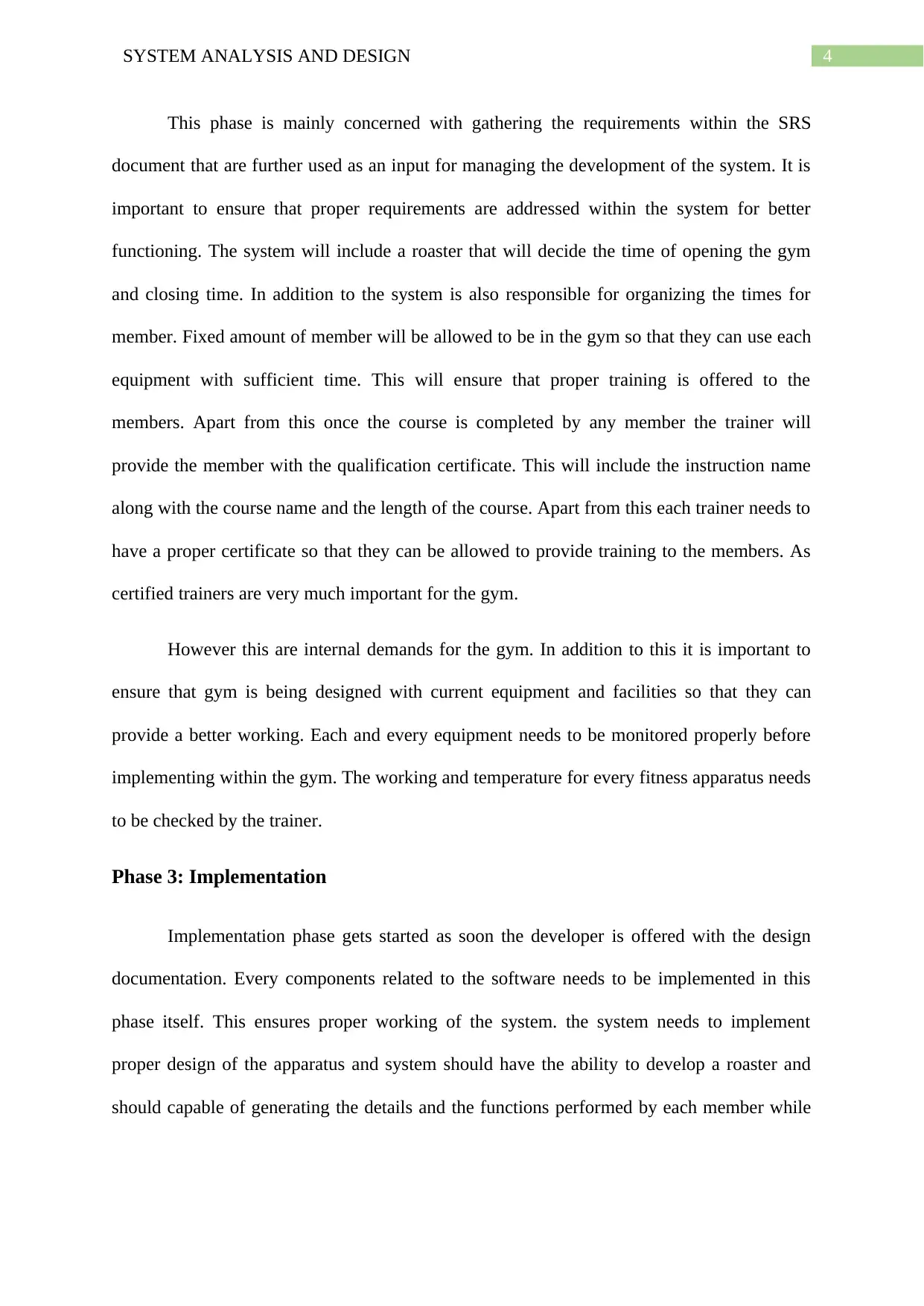
4SYSTEM ANALYSIS AND DESIGN
This phase is mainly concerned with gathering the requirements within the SRS
document that are further used as an input for managing the development of the system. It is
important to ensure that proper requirements are addressed within the system for better
functioning. The system will include a roaster that will decide the time of opening the gym
and closing time. In addition to the system is also responsible for organizing the times for
member. Fixed amount of member will be allowed to be in the gym so that they can use each
equipment with sufficient time. This will ensure that proper training is offered to the
members. Apart from this once the course is completed by any member the trainer will
provide the member with the qualification certificate. This will include the instruction name
along with the course name and the length of the course. Apart from this each trainer needs to
have a proper certificate so that they can be allowed to provide training to the members. As
certified trainers are very much important for the gym.
However this are internal demands for the gym. In addition to this it is important to
ensure that gym is being designed with current equipment and facilities so that they can
provide a better working. Each and every equipment needs to be monitored properly before
implementing within the gym. The working and temperature for every fitness apparatus needs
to be checked by the trainer.
Phase 3: Implementation
Implementation phase gets started as soon the developer is offered with the design
documentation. Every components related to the software needs to be implemented in this
phase itself. This ensures proper working of the system. the system needs to implement
proper design of the apparatus and system should have the ability to develop a roaster and
should capable of generating the details and the functions performed by each member while
This phase is mainly concerned with gathering the requirements within the SRS
document that are further used as an input for managing the development of the system. It is
important to ensure that proper requirements are addressed within the system for better
functioning. The system will include a roaster that will decide the time of opening the gym
and closing time. In addition to the system is also responsible for organizing the times for
member. Fixed amount of member will be allowed to be in the gym so that they can use each
equipment with sufficient time. This will ensure that proper training is offered to the
members. Apart from this once the course is completed by any member the trainer will
provide the member with the qualification certificate. This will include the instruction name
along with the course name and the length of the course. Apart from this each trainer needs to
have a proper certificate so that they can be allowed to provide training to the members. As
certified trainers are very much important for the gym.
However this are internal demands for the gym. In addition to this it is important to
ensure that gym is being designed with current equipment and facilities so that they can
provide a better working. Each and every equipment needs to be monitored properly before
implementing within the gym. The working and temperature for every fitness apparatus needs
to be checked by the trainer.
Phase 3: Implementation
Implementation phase gets started as soon the developer is offered with the design
documentation. Every components related to the software needs to be implemented in this
phase itself. This ensures proper working of the system. the system needs to implement
proper design of the apparatus and system should have the ability to develop a roaster and
should capable of generating the details and the functions performed by each member while
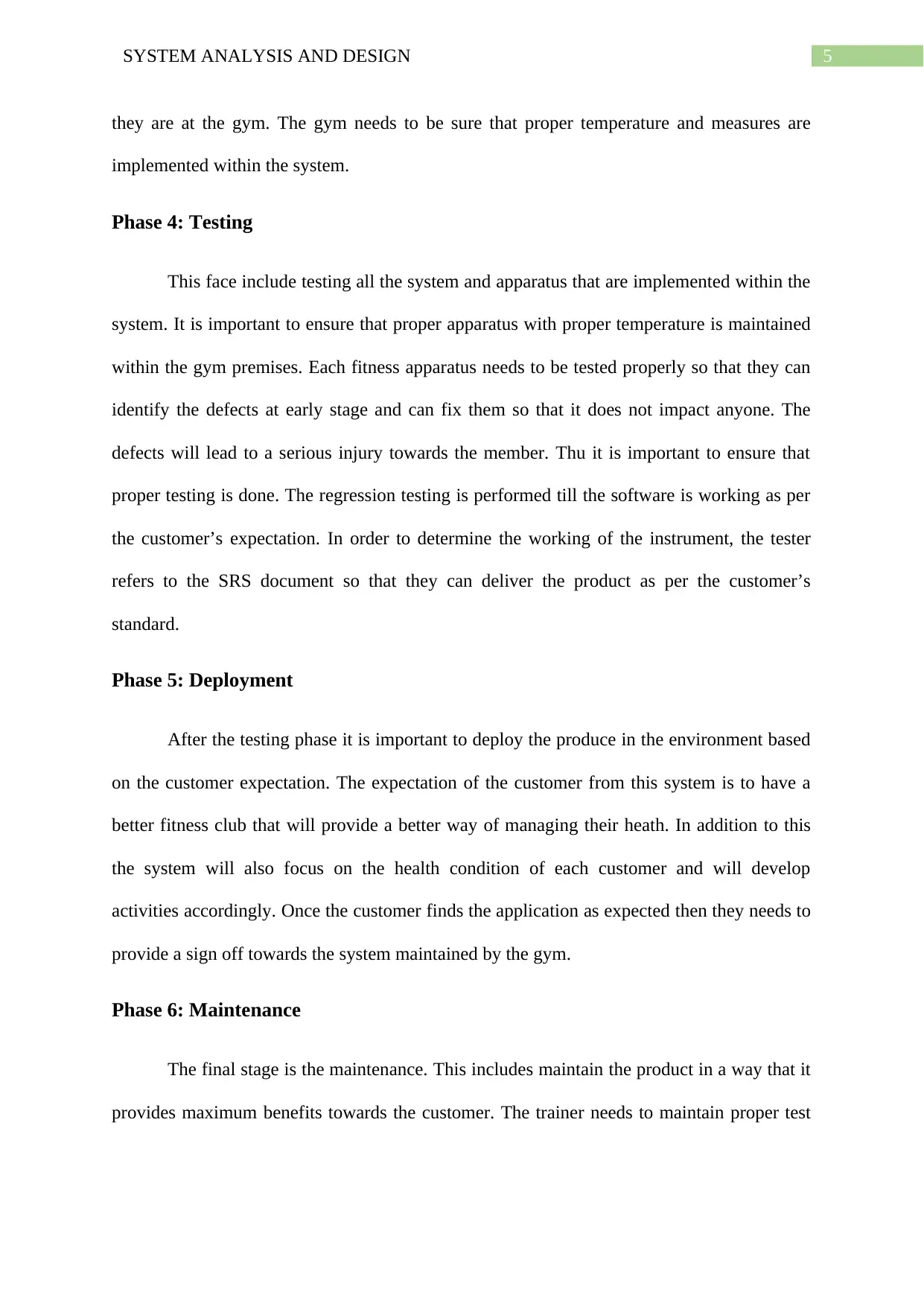
5SYSTEM ANALYSIS AND DESIGN
they are at the gym. The gym needs to be sure that proper temperature and measures are
implemented within the system.
Phase 4: Testing
This face include testing all the system and apparatus that are implemented within the
system. It is important to ensure that proper apparatus with proper temperature is maintained
within the gym premises. Each fitness apparatus needs to be tested properly so that they can
identify the defects at early stage and can fix them so that it does not impact anyone. The
defects will lead to a serious injury towards the member. Thu it is important to ensure that
proper testing is done. The regression testing is performed till the software is working as per
the customer’s expectation. In order to determine the working of the instrument, the tester
refers to the SRS document so that they can deliver the product as per the customer’s
standard.
Phase 5: Deployment
After the testing phase it is important to deploy the produce in the environment based
on the customer expectation. The expectation of the customer from this system is to have a
better fitness club that will provide a better way of managing their heath. In addition to this
the system will also focus on the health condition of each customer and will develop
activities accordingly. Once the customer finds the application as expected then they needs to
provide a sign off towards the system maintained by the gym.
Phase 6: Maintenance
The final stage is the maintenance. This includes maintain the product in a way that it
provides maximum benefits towards the customer. The trainer needs to maintain proper test
they are at the gym. The gym needs to be sure that proper temperature and measures are
implemented within the system.
Phase 4: Testing
This face include testing all the system and apparatus that are implemented within the
system. It is important to ensure that proper apparatus with proper temperature is maintained
within the gym premises. Each fitness apparatus needs to be tested properly so that they can
identify the defects at early stage and can fix them so that it does not impact anyone. The
defects will lead to a serious injury towards the member. Thu it is important to ensure that
proper testing is done. The regression testing is performed till the software is working as per
the customer’s expectation. In order to determine the working of the instrument, the tester
refers to the SRS document so that they can deliver the product as per the customer’s
standard.
Phase 5: Deployment
After the testing phase it is important to deploy the produce in the environment based
on the customer expectation. The expectation of the customer from this system is to have a
better fitness club that will provide a better way of managing their heath. In addition to this
the system will also focus on the health condition of each customer and will develop
activities accordingly. Once the customer finds the application as expected then they needs to
provide a sign off towards the system maintained by the gym.
Phase 6: Maintenance
The final stage is the maintenance. This includes maintain the product in a way that it
provides maximum benefits towards the customer. The trainer needs to maintain proper test
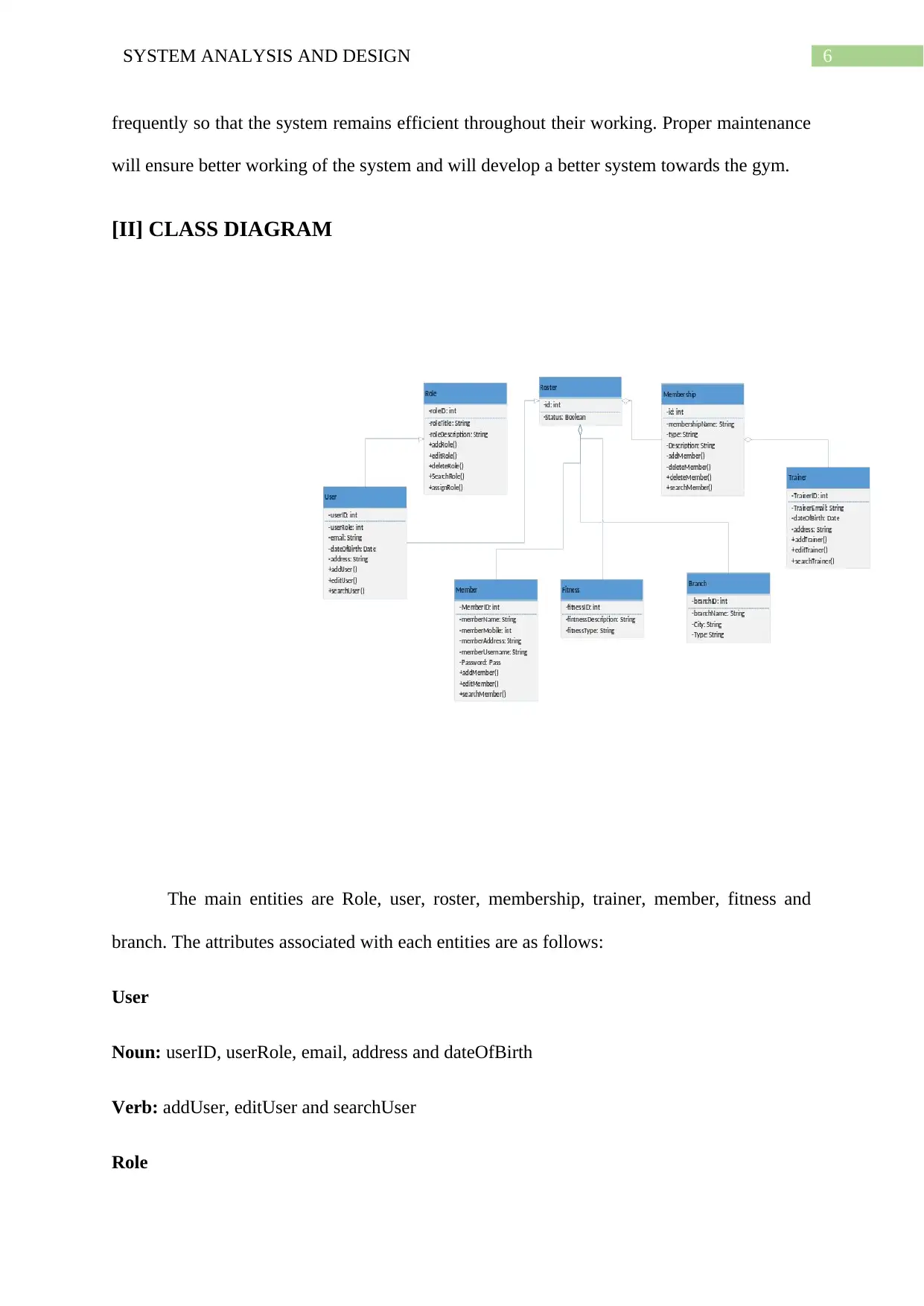
6SYSTEM ANALYSIS AND DESIGN
frequently so that the system remains efficient throughout their working. Proper maintenance
will ensure better working of the system and will develop a better system towards the gym.
[II] CLASS DIAGRAM
The main entities are Role, user, roster, membership, trainer, member, fitness and
branch. The attributes associated with each entities are as follows:
User
Noun: userID, userRole, email, address and dateOfBirth
Verb: addUser, editUser and searchUser
Role
frequently so that the system remains efficient throughout their working. Proper maintenance
will ensure better working of the system and will develop a better system towards the gym.
[II] CLASS DIAGRAM
The main entities are Role, user, roster, membership, trainer, member, fitness and
branch. The attributes associated with each entities are as follows:
User
Noun: userID, userRole, email, address and dateOfBirth
Verb: addUser, editUser and searchUser
Role
Paraphrase This Document
Need a fresh take? Get an instant paraphrase of this document with our AI Paraphraser
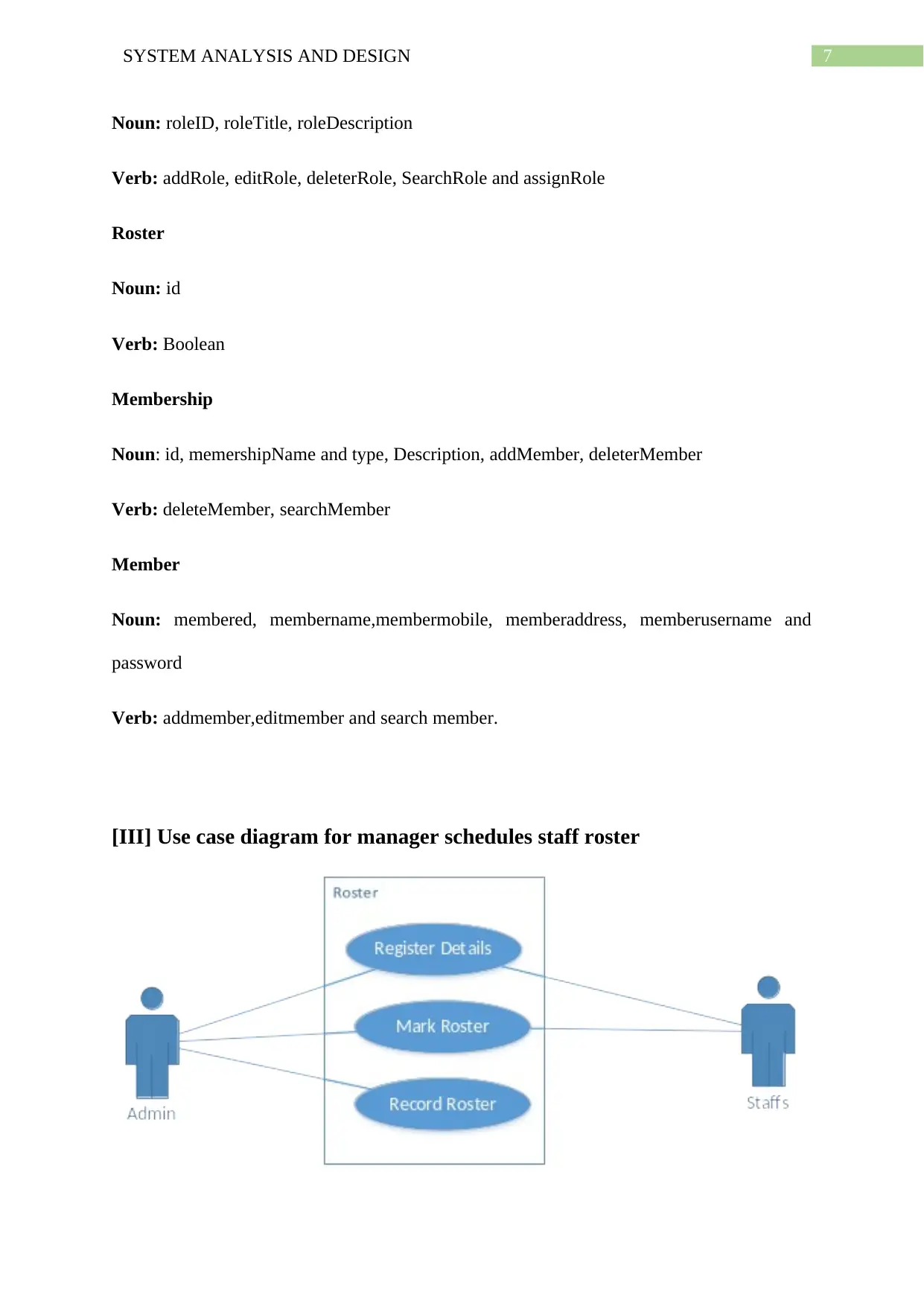
7SYSTEM ANALYSIS AND DESIGN
Noun: roleID, roleTitle, roleDescription
Verb: addRole, editRole, deleterRole, SearchRole and assignRole
Roster
Noun: id
Verb: Boolean
Membership
Noun: id, memershipName and type, Description, addMember, deleterMember
Verb: deleteMember, searchMember
Member
Noun: membered, membername,membermobile, memberaddress, memberusername and
password
Verb: addmember,editmember and search member.
[III] Use case diagram for manager schedules staff roster
Noun: roleID, roleTitle, roleDescription
Verb: addRole, editRole, deleterRole, SearchRole and assignRole
Roster
Noun: id
Verb: Boolean
Membership
Noun: id, memershipName and type, Description, addMember, deleterMember
Verb: deleteMember, searchMember
Member
Noun: membered, membername,membermobile, memberaddress, memberusername and
password
Verb: addmember,editmember and search member.
[III] Use case diagram for manager schedules staff roster
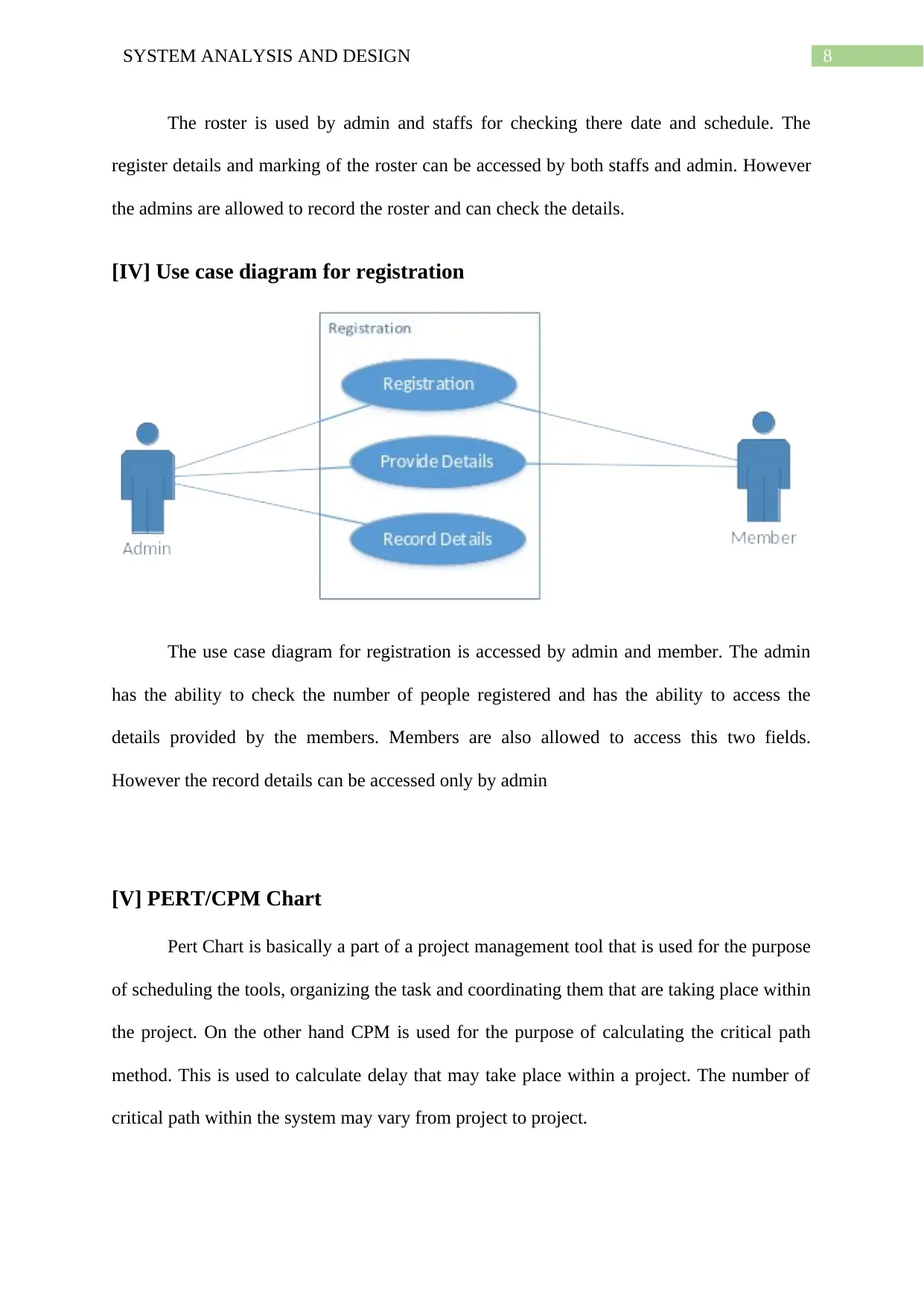
8SYSTEM ANALYSIS AND DESIGN
The roster is used by admin and staffs for checking there date and schedule. The
register details and marking of the roster can be accessed by both staffs and admin. However
the admins are allowed to record the roster and can check the details.
[IV] Use case diagram for registration
The use case diagram for registration is accessed by admin and member. The admin
has the ability to check the number of people registered and has the ability to access the
details provided by the members. Members are also allowed to access this two fields.
However the record details can be accessed only by admin
[V] PERT/CPM Chart
Pert Chart is basically a part of a project management tool that is used for the purpose
of scheduling the tools, organizing the task and coordinating them that are taking place within
the project. On the other hand CPM is used for the purpose of calculating the critical path
method. This is used to calculate delay that may take place within a project. The number of
critical path within the system may vary from project to project.
The roster is used by admin and staffs for checking there date and schedule. The
register details and marking of the roster can be accessed by both staffs and admin. However
the admins are allowed to record the roster and can check the details.
[IV] Use case diagram for registration
The use case diagram for registration is accessed by admin and member. The admin
has the ability to check the number of people registered and has the ability to access the
details provided by the members. Members are also allowed to access this two fields.
However the record details can be accessed only by admin
[V] PERT/CPM Chart
Pert Chart is basically a part of a project management tool that is used for the purpose
of scheduling the tools, organizing the task and coordinating them that are taking place within
the project. On the other hand CPM is used for the purpose of calculating the critical path
method. This is used to calculate delay that may take place within a project. The number of
critical path within the system may vary from project to project.
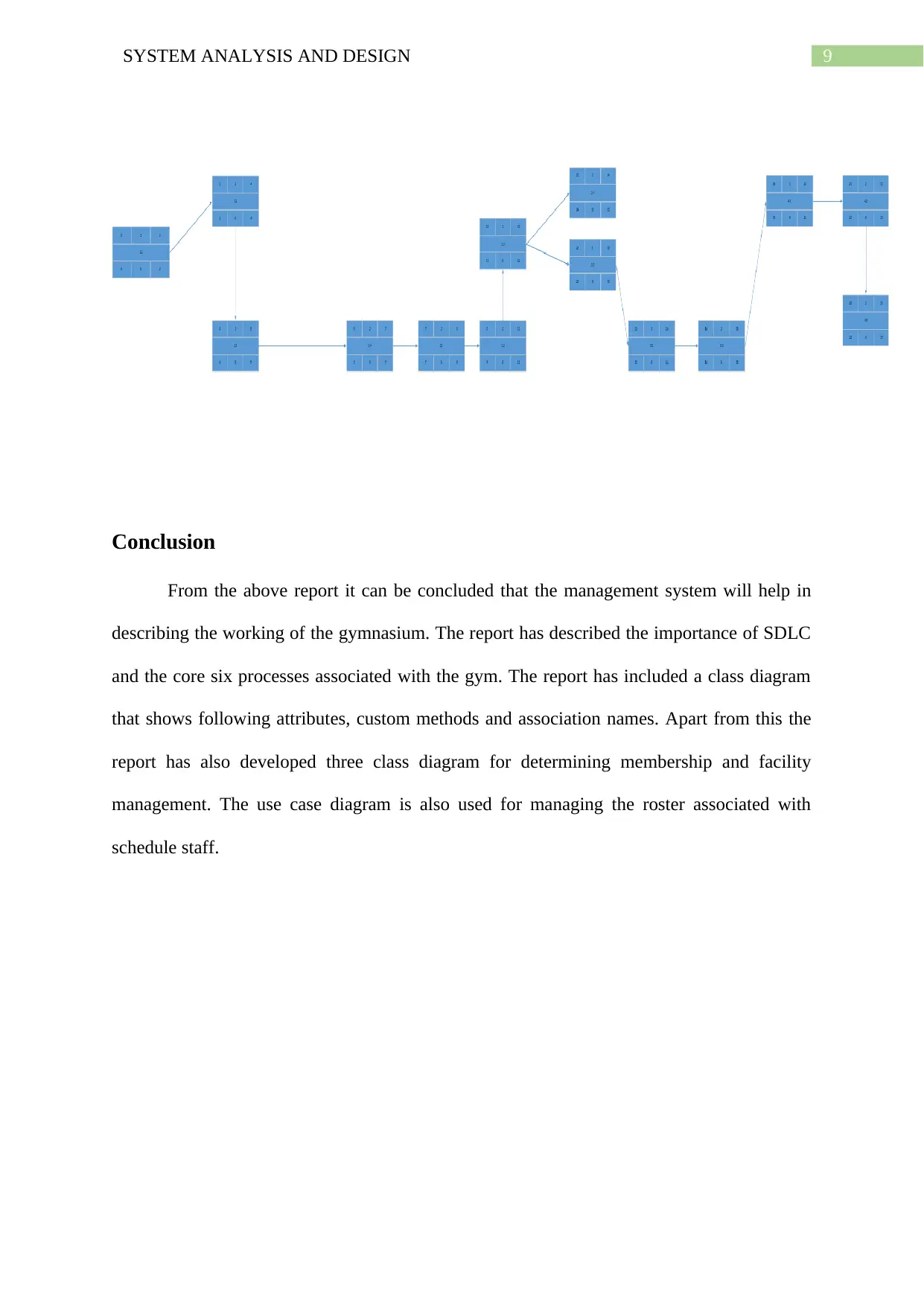
9SYSTEM ANALYSIS AND DESIGN
Conclusion
From the above report it can be concluded that the management system will help in
describing the working of the gymnasium. The report has described the importance of SDLC
and the core six processes associated with the gym. The report has included a class diagram
that shows following attributes, custom methods and association names. Apart from this the
report has also developed three class diagram for determining membership and facility
management. The use case diagram is also used for managing the roster associated with
schedule staff.
Conclusion
From the above report it can be concluded that the management system will help in
describing the working of the gymnasium. The report has described the importance of SDLC
and the core six processes associated with the gym. The report has included a class diagram
that shows following attributes, custom methods and association names. Apart from this the
report has also developed three class diagram for determining membership and facility
management. The use case diagram is also used for managing the roster associated with
schedule staff.
Secure Best Marks with AI Grader
Need help grading? Try our AI Grader for instant feedback on your assignments.
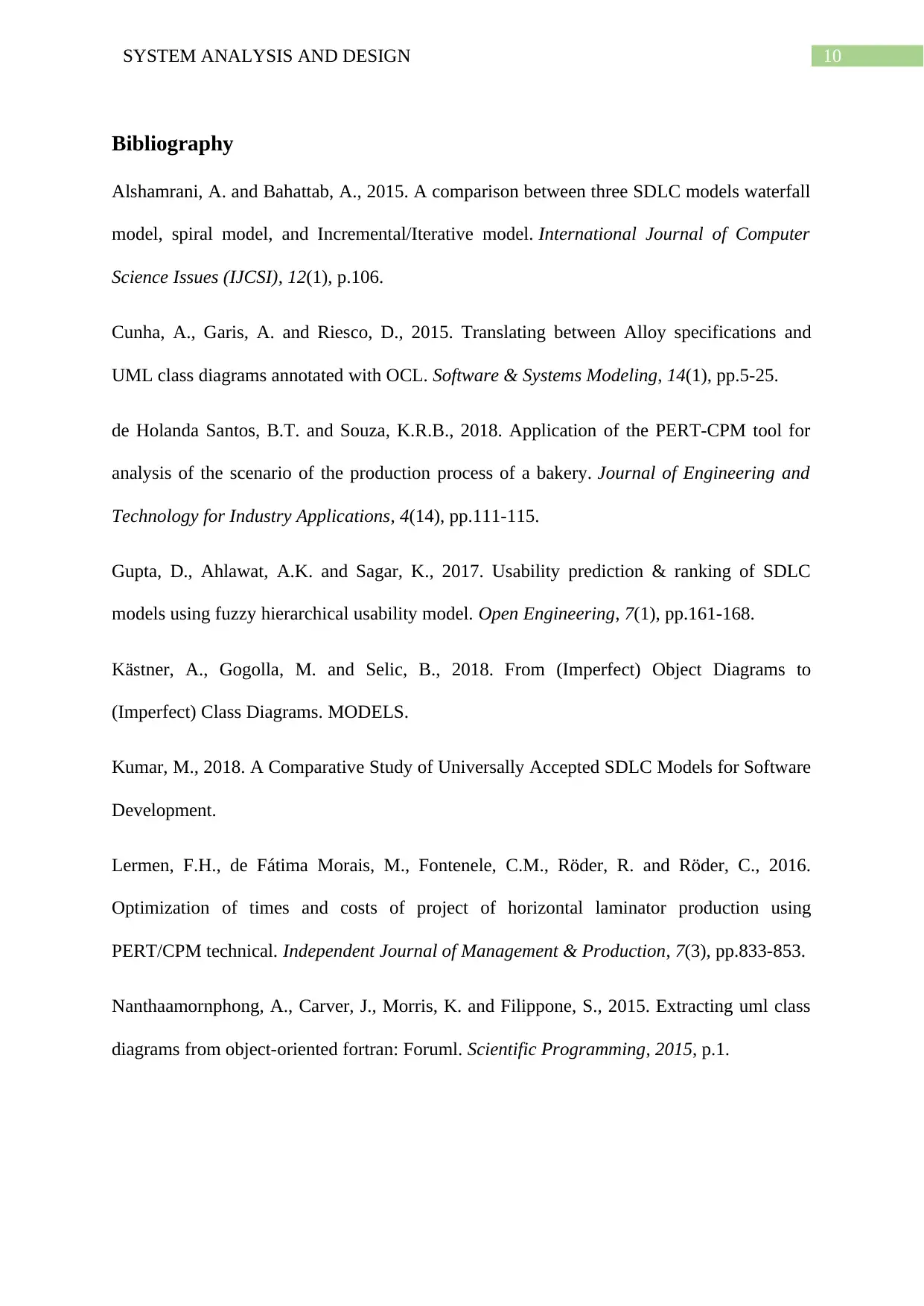
10SYSTEM ANALYSIS AND DESIGN
Bibliography
Alshamrani, A. and Bahattab, A., 2015. A comparison between three SDLC models waterfall
model, spiral model, and Incremental/Iterative model. International Journal of Computer
Science Issues (IJCSI), 12(1), p.106.
Cunha, A., Garis, A. and Riesco, D., 2015. Translating between Alloy specifications and
UML class diagrams annotated with OCL. Software & Systems Modeling, 14(1), pp.5-25.
de Holanda Santos, B.T. and Souza, K.R.B., 2018. Application of the PERT-CPM tool for
analysis of the scenario of the production process of a bakery. Journal of Engineering and
Technology for Industry Applications, 4(14), pp.111-115.
Gupta, D., Ahlawat, A.K. and Sagar, K., 2017. Usability prediction & ranking of SDLC
models using fuzzy hierarchical usability model. Open Engineering, 7(1), pp.161-168.
Kästner, A., Gogolla, M. and Selic, B., 2018. From (Imperfect) Object Diagrams to
(Imperfect) Class Diagrams. MODELS.
Kumar, M., 2018. A Comparative Study of Universally Accepted SDLC Models for Software
Development.
Lermen, F.H., de Fátima Morais, M., Fontenele, C.M., Röder, R. and Röder, C., 2016.
Optimization of times and costs of project of horizontal laminator production using
PERT/CPM technical. Independent Journal of Management & Production, 7(3), pp.833-853.
Nanthaamornphong, A., Carver, J., Morris, K. and Filippone, S., 2015. Extracting uml class
diagrams from object-oriented fortran: Foruml. Scientific Programming, 2015, p.1.
Bibliography
Alshamrani, A. and Bahattab, A., 2015. A comparison between three SDLC models waterfall
model, spiral model, and Incremental/Iterative model. International Journal of Computer
Science Issues (IJCSI), 12(1), p.106.
Cunha, A., Garis, A. and Riesco, D., 2015. Translating between Alloy specifications and
UML class diagrams annotated with OCL. Software & Systems Modeling, 14(1), pp.5-25.
de Holanda Santos, B.T. and Souza, K.R.B., 2018. Application of the PERT-CPM tool for
analysis of the scenario of the production process of a bakery. Journal of Engineering and
Technology for Industry Applications, 4(14), pp.111-115.
Gupta, D., Ahlawat, A.K. and Sagar, K., 2017. Usability prediction & ranking of SDLC
models using fuzzy hierarchical usability model. Open Engineering, 7(1), pp.161-168.
Kästner, A., Gogolla, M. and Selic, B., 2018. From (Imperfect) Object Diagrams to
(Imperfect) Class Diagrams. MODELS.
Kumar, M., 2018. A Comparative Study of Universally Accepted SDLC Models for Software
Development.
Lermen, F.H., de Fátima Morais, M., Fontenele, C.M., Röder, R. and Röder, C., 2016.
Optimization of times and costs of project of horizontal laminator production using
PERT/CPM technical. Independent Journal of Management & Production, 7(3), pp.833-853.
Nanthaamornphong, A., Carver, J., Morris, K. and Filippone, S., 2015. Extracting uml class
diagrams from object-oriented fortran: Foruml. Scientific Programming, 2015, p.1.
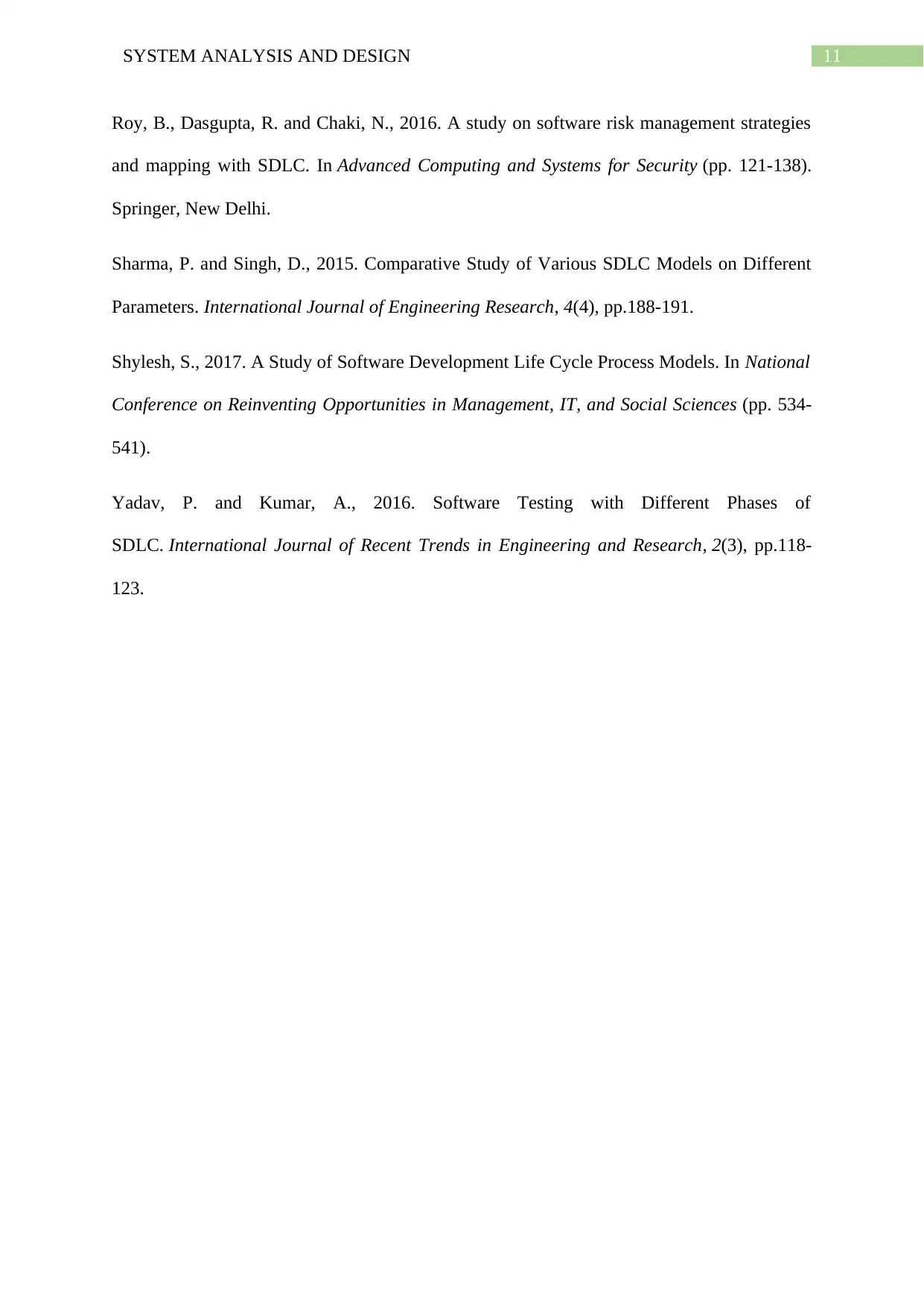
11SYSTEM ANALYSIS AND DESIGN
Roy, B., Dasgupta, R. and Chaki, N., 2016. A study on software risk management strategies
and mapping with SDLC. In Advanced Computing and Systems for Security (pp. 121-138).
Springer, New Delhi.
Sharma, P. and Singh, D., 2015. Comparative Study of Various SDLC Models on Different
Parameters. International Journal of Engineering Research, 4(4), pp.188-191.
Shylesh, S., 2017. A Study of Software Development Life Cycle Process Models. In National
Conference on Reinventing Opportunities in Management, IT, and Social Sciences (pp. 534-
541).
Yadav, P. and Kumar, A., 2016. Software Testing with Different Phases of
SDLC. International Journal of Recent Trends in Engineering and Research, 2(3), pp.118-
123.
Roy, B., Dasgupta, R. and Chaki, N., 2016. A study on software risk management strategies
and mapping with SDLC. In Advanced Computing and Systems for Security (pp. 121-138).
Springer, New Delhi.
Sharma, P. and Singh, D., 2015. Comparative Study of Various SDLC Models on Different
Parameters. International Journal of Engineering Research, 4(4), pp.188-191.
Shylesh, S., 2017. A Study of Software Development Life Cycle Process Models. In National
Conference on Reinventing Opportunities in Management, IT, and Social Sciences (pp. 534-
541).
Yadav, P. and Kumar, A., 2016. Software Testing with Different Phases of
SDLC. International Journal of Recent Trends in Engineering and Research, 2(3), pp.118-
123.
1 out of 12
Related Documents
Your All-in-One AI-Powered Toolkit for Academic Success.
+13062052269
info@desklib.com
Available 24*7 on WhatsApp / Email
![[object Object]](/_next/static/media/star-bottom.7253800d.svg)
Unlock your academic potential
© 2024 | Zucol Services PVT LTD | All rights reserved.





